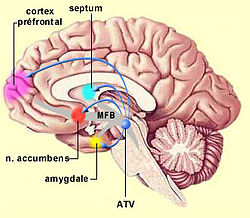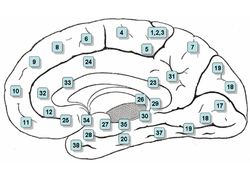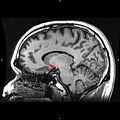- Nucleus accumbens
-
Brain: Nucleus accumbens 
Nucleus accumbens visible in red. 
Medial surface, person facing to the left. Nucleus accumbens is very roughly in the area labeled 34. Latin nucleus accumbens septi NeuroNames hier-259 MeSH Nucleus+Accumbens NeuroLex ID birnlex_727 The nucleus accumbens (NAcc), also known as the accumbens nucleus or as the nucleus accumbens septi (Latin for nucleus leaning against the septum), is a collection of neurons and forms the main part of the ventral striatum. It is thought to play an important role in reward, pleasure, laughter, addiction, aggression, fear, and the placebo effect.[1][2][3]
Each half of the brain has one nucleus accumbens. It is located where the head of the caudate and the anterior portion of the putamen meet just lateral to the septum pellucidum. The nucleus accumbens and the olfactory tubercle collectively form the ventral striatum, which is part of the basal ganglia.[4]
The nucleus accumbens can be divided into two structures—the nucleus accumbens core and the nucleus accumbens shell. These structures have different morphology and function.
Contents
Cell types
The principal neuronal cell type found in the nucleus accumbens is the medium spiny neuron. The neurotransmitter produced by these neurons is gamma-aminobutyric acid (GABA), one of the main inhibitory neurotransmitters of the central nervous system. These neurons are also the main projection or output neurons of the nucleus accumbens.
While 95% of the neurons in the nucleus accumbens are medium spiny GABA-ergic projection neurons, other neuronal types are also found such as large aspiny cholinergic interneurons.
Output and input
Output
The output neurons of the nucleus accumbens send axon projections to the ventral analog of the globus pallidus, known as the ventral pallidum (VP). The VP, in turn, projects to the medial dorsal nucleus of the dorsal thalamus, which projects to the prefrontal cortex as well as the striatum. Other efferents from the nucleus accumbens include connections with the substantia nigra and the pontine reticular formation.
Input
Major inputs to the nucleus accumbens include prefrontal association cortices, basolateral amygdala, and dopaminergic neurons located in the ventral tegmental area (VTA), which connect via the mesolimbic pathway. Thus the nucleus accumbens is often described as one part of a cortico-striato-thalamo-cortical loop.
Dopaminergic input from the VTA is thought to modulate the activity of neurons within the nucleus accumbens. These terminals are also the site of action of highly-addictive drugs such as cocaine and amphetamine, which cause a manifold increase in dopamine levels in the nucleus accumbens. In addition to cocaine and amphetamine, almost every recreational drug has been shown to increase dopamine levels in the nucleus accumbens.
Another major source of input comes from the CA1 and ventral subiculum of the hippocampus to the dorsomedial area of the Nucleus accumbens. The neurons of the hippocampus have a noteworthy correlation to slight depolarizations of cells in the nucleus accumbens, which makes them more positive and therefore more excitable. The correlated cells of these excited states of the medium spiny neurons in the Nucleus accumbens are shared equally between the subiculum and CA1. The subiculum neurons are found to hyperpolarize(increase negativity) while the CA1 neurons "ripple"(fire > 50 Hz) in order to accomplish this priming. [5]
Research
In the 1950s, James Olds and Peter Milner implanted electrodes into the septal area of the rat and found that the rat chose to press a lever which stimulated it. It continued to prefer this even over stopping to eat or drink. This suggests that the area is the 'pleasure center' of the brain. The septal nuclei are not directly connected to the nucleus accumbens, however.[6]
Although the nucleus accumbens has traditionally been studied for its role in addiction, it plays an equal role in processing many rewards such as food and sex. Interestingly, the nucleus accumbens is selectively activated during the perception of pleasant, emotionally arousing pictures and during mental imagery of pleasant, emotional scenes.[7][8] A 2005 study found that it is involved in the regulation of emotions induced by music,[9] perhaps consequent to its role in mediating dopamine release. The nucleus accumbens plays a role in rhythmic timing and is considered to be of central importance to the limbic-motor interface (Mogensen).
In April 2007, two research teams reported on having inserted electrodes into the nucleus accumbens in order to use deep brain stimulation to treat severe depression.[10]
In addition, in July 2007, researcher Jon-Kar Zubieta published findings that the nucleus accumbens is central to the machinery of the placebo effect. His group has confirmed that specific neural circuits and neurotransmitter systems respond to the expectation of benefit during placebo administration and that these expectations induce measurable physiological changes.[11]
The nucleus accumbens has been targeted by stereotactic surgery for ablation as a treatment in China for alcoholism.[12]
Additional images
References
- ^ Schwienbacher I, Fendt M, Richardson R, Schnitzler HU (2004). "Temporary inactivation of the nucleus accumbens disrupts acquisition and expression of fear-potentiated startle in rats". Brain Res. 1027 (1–2): 87–93. doi:10.1016/j.brainres.2004.08.037. PMID 15494160.
- ^ The Placebo Effect in the NAC
- ^ Dopamine Involved In Aggression - Medical News Today
- ^ Nucleus Accumbens
- ^ O'Donnell, P., Goto, Y. (2001). "Synchronous activity in the hippocampus and nucleus accumbens in vivo". J. Neurosci. 21 (4): RC131. PMID 11160416.
- ^ Olds J, Milner P (1954). "Positive reinforcement produced by electrical stimulation of septal area and other regions of rat brain". J Comp Physiol Psychol 47 (6): 419–27. doi:10.1037/h0058775. PMID 13233369. article
- ^ Costa, VD, Lang, PJ, Sabatinelli, D, Bradley MM, and Versace, F (2010). "Emotional imagery: Assessing pleasure and arousal in the brain's reward circuitry". Human Brain Mapping 31 (9): 1446–1457. doi:10.1002/hbm.20948. PMID 20127869.
- ^ Sabatinelli, D, Lang, PJ, Bradley, MM, Costa, VD, and Versace, F (2007). "Pleasure rather than salience activates human nucleus accumbens and medial prefrontal cortex". Journal of Neurophysiology 98 (9): 1374–1379. doi:10.1152/jn.00230.2007. PMID 17596422.
- ^ Menon, Vinod & Levitin, Daniel J. (2005) The rewards of music listening: Response and physiological connectivity of themesolimbic system." NeuroImage 28(1), pp. 175-184
- ^ Brain Electrodes Help Treat Depression, Technology Review, 26 April 2007
- ^ http://www.eurekalert.org/pub_releases/2007-07/cp-brc071607.php Brain region central to placebo effect identified
- ^ Wu HM, Wang XL, Chang CW, Li N, Gao L, Geng N, Ma JH, Zhao W, Gao GD. (2010). Preliminary findings in ablating the nucleus accumbens using stereotactic surgery for alleviating psychological dependence on alcohol. Neurosci Lett. 473: 77–81 doi:10.1016/j.neulet.2010.02.019 PMID 20156524
External links
- The role of the nucleus accumbens in the reward circuit. Part of "The Brain From Top to Bottom." at thebrain.mcgill.ca
- Nucleus Accumbens - Cell Centered Database
- BrainMaps at UCDavis nucleus%20accumbens
Human brain, cerebrum, Interior of the cerebral hemispheres—Rostral Basal ganglia and associated structures (TA A14.1.09.321–552, GA 9.832–837) Basal ganglia Ventral striatumOtherInternal capsule (Anterior limb · Genu · Posterior limb, Optic radiation)
Corona radiata · External capsule · Extreme capsule
Pallidothalamic tracts: Thalamic fasciculus (Ansa lenticularis, Lenticular fasciculus) · Subthalamic fasciculusRhinencephalon Other basal forebrain Diagonal band of Broca · Stria terminalisArchicortex:
Hippocampal formation/
Hippocampus anatomyNeurotransmitter systems Acetylcholine BA/M Mesocortical pathway: Ventral tegmental area → Frontal cortex
Mesolimbic pathway: Ventral tegmental area → Nucleus accumbens
Nigrostriatal pathway: Pars compacta → Striatum
Tuberoinfundibular pathway: Hypothalamus → Pituitary glandSerotonin pathwaysAA Categories:
Wikimedia Foundation. 2010.



